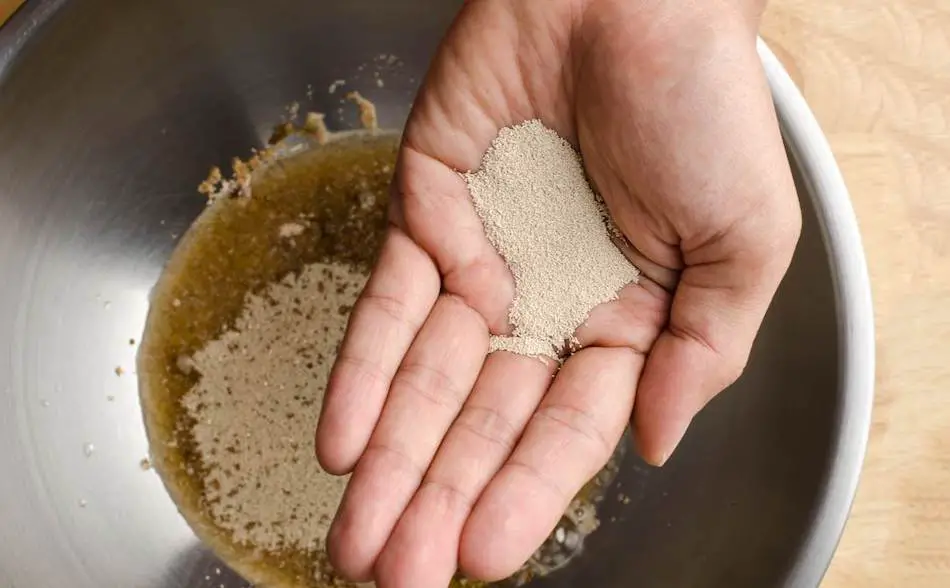
Did you know that you can make bread without yeast using a bread machine? Fortunately, with a bread machine and a few simple ingredients, you can still enjoy freshly baked bread without yeast. Yeast-free bread machine bread is not only easy to make, but it’s also a great option for those who are sensitive to or allergic to yeast, or for those who simply prefer the taste and texture of bread made without it. In this guide, we’ll explore the ins and outs of yeast-free bread machine baking, including tips, tricks, and delicious recipes to get you started.
There are several methods for making yeast-free bread, including using baking powder, baking soda, sourdough starter, yogurt, or vinegar. Baking powder is a combination of baking soda and an acid that provides quick and convenient leavening. Baking soda, when combined with an acidic ingredient, such as vinegar or yogurt, can help the bread rise. Sourdough starter is a mixture of flour and water that has been fermented by yeast and bacteria, providing a unique flavor and texture. Yogurt contains lactic acid that can help the bread rise and add a tangy flavor, while vinegar’s acidity can help the bread rise but may also affect the flavor. Each of these yeast alternatives provides a different taste and texture, so it is important to choose the one that best fits your desired outcome.
- Yeast is a key ingredient in traditional bread-making, as it helps the bread rise and provides its distinctive flavor.
- Alternatives to yeast in bread-making include baking powder, baking soda, sourdough starter, yogurt, and vinegar.
- Baking powder is a combination of baking soda and acid, providing quick and convenient leavening.
- Baking soda, when combined with an acidic ingredient, can help the bread rise.
- Sourdough starter is a mixture of flour and water that has been fermented by yeast and bacteria, providing a unique flavor and texture.
- Yogurt contains lactic acid that can help the bread rise and add a tangy flavor.
- Vinegar’s acidity can help the bread rise but may also affect the flavor.
- Each yeast alternative provides a different taste and texture, and it is important to choose the one that best fits your desired outcome.
- To use yeast alternatives in a bread machine, follow the instructions provided for each individual alternative.
Yeast Alternatives for Bread Machine Bread
Using a bread machine to make yeast-free bread is a simple and efficient process – the machine takes care of the mixing, kneading, and rising, leaving you with a perfectly baked loaf. Instead of yeast, yeast-free bread machine recipes typically use baking powder and/or baking soda as a leavening agent. These ingredients react with the liquid and create carbon dioxide, causing the bread to rise. With a few basic ingredients and a bread machine, you can easily create delicious and nutritious yeast-free bread at home.
| Bread Type | Flour | Yeast Alternative | Salt | Liquid | Fat | Sweetener | Mix-ins |
|---|---|---|---|---|---|---|---|
| Baking Powder Bread | 3 cups | 6 tsp baking powder | 1 tsp | 1 1/4 cups water | 2 tbsp olive oil | 2 tbsp honey | Optional: 1/4 cup oats or seeds |
| Baking Soda Bread | 2 cups all-purpose flour + 1 cup whole wheat flour | 1 tsp baking soda + 1 tbsp vinegar | 1 tsp | 1 1/4 cups buttermilk | 2 tbsp butter, melted | 1 tbsp honey | Optional: 1/4 cup nuts or dried fruit |
| Sourdough Bread | 3 cups bread flour | 1 cup sourdough starter | 1 1/2 tsp | 1 cup water | 2 tbsp olive oil | 1 tbsp honey | Optional: 1/4 cup grated cheese or olives |
| Yogurt Bread | 3 cups all-purpose flour | 1 cup plain yogurt + 1 tsp baking soda | 1 tsp | 1/2 cup milk + 3/4 cup water | 2 tbsp olive oil | 1 tbsp honey | Optional: 1/4 cup sun-dried tomatoes or herbs |
Do You Need Yeast to Make Bread?
Bread machine bread usually requires yeast to rise and create a soft and fluffy texture. Without yeast, the dough will not rise and the final product will likely be dense and heavy. The texture and flavor of the bread will also be different as yeast contributes to the development of gluten, which helps to provide structure to the bread, as well as contributes to the flavor through fermentation
Yeast Free Bread FAQs
Can you make bread without yeast in a bread machine? Yes, it is possible to make bread without yeast in a bread machine by using alternative leavening agents such as baking powder or baking soda.
What are the consequences of not using yeast in bread machine bread? Without yeast, the bread will not rise and will likely have a dense and heavy texture. The flavor of the bread will also be different as yeast contributes to the flavor through fermentation.
How does the dough differ when making yeast-free bread in a bread machine? The dough for yeast-free bread will be thicker and more compact compared to dough that uses yeast, which is lighter and airier.
Can yeast-free bread made in a bread machine still be soft and fluffy? It can be challenging to achieve a soft and fluffy texture without yeast, but by using other leavening agents and proper technique, it is possible to produce a light and tender bread.
What are some alternative ingredients to yeast in a bread machine? Baking powder, baking soda, sourdough starter, yogurt, and vinegar are some common alternative ingredients that can be used instead of yeast in a bread machine to create a rise in the dough.
What is Yeast?
Yeast is a crucial ingredient when it comes to making bread. Yeast is a type of fungus that ferments the sugars in the dough, producing carbon dioxide which makes the dough rise. Without yeast, bread will not rise and will end up being dense and heavy.
Yeast is like the backbone of bread-making, giving it that soft, airy texture that we all love. It’s what makes the bread light and fluffy, and gives it that distinct flavor through fermentation. So, if you want to make bread that’s truly worth eating, you must have yeast in your pantry.
Are there alternatives to yeast that we can use?
There are several yeast alternatives that can be used in bread-making. Some of these include:
- Baking Powder: A combination of baking soda and acid, it provides a quick and convenient leavening option.
- Baking Soda: When combined with an acidic ingredient such as vinegar or yogurt, it can help the bread rise.
- Sourdough Starter: A mixture of flour and water that has been fermented by naturally occurring yeast and bacteria. It can be used to create a sourdough bread that has a unique flavor and texture.
- Yogurt: Contains lactic acid that can help the bread rise and add a tangy flavor.
- Vinegar: The acidity of vinegar can help the bread rise, but it can also affect the flavor.
While these alternatives can provide a rise in bread dough, they do not have the same leavening power and flavor contribution as yeast, so the end product will have a different texture and flavor compared to bread made with yeast.
Baking Powder
Baking powder is a combination of baking soda and acid, which helps to provide a quick rise to the dough. However, it’s important to keep in mind that baking powder doesn’t have the same leavening power as yeast. It’s a bit of a shortcut, if you will. The final product will have a slightly different texture and flavor compared to bread made with yeast.
So, if you’re looking for that classic, fluffy bread with a delicate flavor, I would recommend using yeast. But, if you’re in a rush and need a quick fix, then baking powder will do the job. Just don’t expect it to be a true work of culinary art.
| Yeast Alternative | Pros | Cons |
|---|---|---|
| Baking Powder | Quick and convenient leavening option | Can produce a slightly different flavor and texture compared to yeast-leavened bread |
| Baking Soda | Provides a rise when combined with an acidic ingredient | Can affect the flavor of the bread |
| Sourdough Starter | Creates a unique flavor and texture | Can take several days to prepare and requires ongoing maintenance |
| Yogurt | Adds tangy flavor and helps the bread rise | Can affect the flavor of the bread |
| Vinegar | Helps the bread rise | Can affect the flavor of the bread |
Sourdough Starter
Sourdough starter is a mixture of flour and water that’s been fermented by naturally occurring yeast and bacteria, it’s used to create sourdough bread that has a unique flavor and texture.
If you’re looking to add some depth and character to your bread, then sourdough starter is the way to go. The fermented mixture creates a sour flavor that’s highly sought after by bread connoisseurs.
However, it’s important to note that sourdough starter takes time to prepare and maintain. You’ll need to be patient and dedicated, my friends. You’ll need to feed the mixture regularly and wait several days for it to ferment and be ready to use in your bread.
So, if you’re up for the challenge and have the time, sourdough starter can provide a delicious and unique twist on traditional bread-making. But, if you’re looking for a quick and convenient solution, then perhaps sourdough starter isn’t the right choice for you.
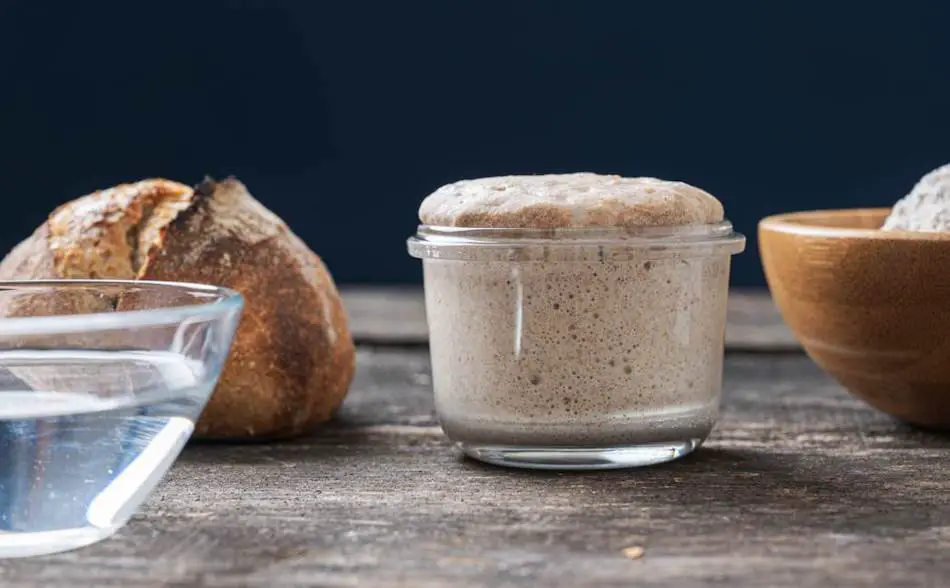
Sourdough Starter Step-by-Step
| Step | What to do |
|---|---|
| 1 | Combine equal parts all-purpose flour and warm water (e.g. 1 cup each) in a large, non-reactive bowl (e.g. glass or ceramic). Mix well until the mixture forms a smooth batter. |
| 2 | Cover the bowl with a cloth and let it sit in a warm, draft-free place for 24 hours. |
| 3 | After 24 hours, discard half of the mixture and add equal parts flour and water to the remaining mixture (e.g. 1 cup each). Mix well until the mixture forms a smooth batter. |
| 4 | Repeat the feeding process (step 3) once a day for 3 to 5 days or until the mixture becomes active and bubbly. |
| 5 | When the mixture is active and bubbly, it’s ready to use in baking or can be stored in the refrigerator. Before using, you should feed the mixture one more time by discarding half and adding equal parts flour and water. Let it sit at room temperature for several hours or until it becomes active and bubbly. |
Sourdough Starter in a Bread Machine
- Prepare the sourdough starter according to the step-by-step guide mentioned earlier.
- Combine the ingredients for the bread dough in the bread machine pan in the order recommended by the manufacturer.
- Add the sourdough starter to the pan last, after the other ingredients.
- Select the appropriate cycle on the bread machine (usually a “dough” or “manual” cycle) and start the machine.
- Once the dough has finished the cycle, remove it from the bread machine and shape it into a loaf. Place it in a greased loaf pan and let it rise in a warm, draft-free place until doubled in size.
- Preheat the oven to 425°F (220°C). Bake the bread for 30 to 40 minutes or until the crust is golden brown.
- Let the bread cool completely on a wire rack before slicing and serving.
Yogurt as a Yeast Substitute
Yogurt can be a great substitute for yeast in bread making. It adds a tangy flavor and acidity to the dough that can help it rise, just like yeast.
Here’s how you can use yogurt as a yeast substitute:
- In place of yeast, add an equal amount of plain, unsweetened yogurt to your bread dough.
- Mix the yogurt into the other ingredients thoroughly.
- Knead the dough and let it rise as usual, until doubled in size.
- Bake the bread according to your recipe.
Keep in mind, using yogurt in place of yeast can affect the flavor and texture of your bread, so it’s not a suitable substitute for every type of bread recipe. But if you’re looking for a tangy twist in your bread, give yogurt a shot.
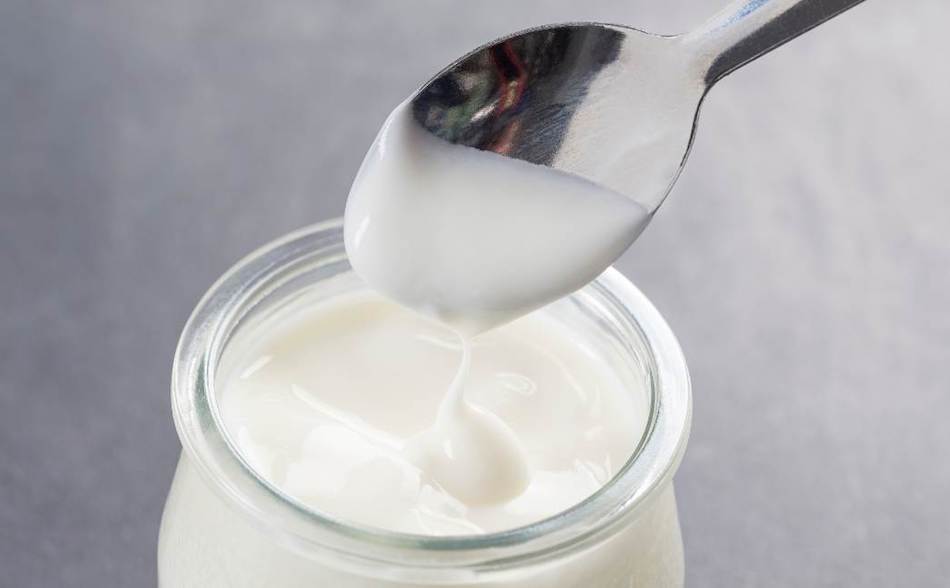
The Science Behind Yogurt as a Yeast Substitute
The acidity in yogurt helps yeast work by creating an environment that allows yeast to grow and ferment. The lactic acid bacteria in yogurt produce lactic acid as they ferment lactose (milk sugar). This lactic acid lowers the pH of the dough, creating an acidic environment that encourages yeast growth and fermentation.
As the yeast ferments the sugars in the dough, it releases carbon dioxide gas. This gas gets trapped in the gluten network of the dough, causing it to rise and become light and airy.
When yogurt is used as a substitute for yeast, it provides both the acidity and the bacteria needed for fermentation to occur. This makes it a convenient and effective alternative to yeast, especially when you don’t have any yeast on hand.
It’s important to note that using yogurt as a yeast substitute can result in a different flavor and texture compared to using yeast. The lactic acid in yogurt can impart a tangy flavor, and the type and amount of bacteria in the yogurt can affect the final texture of the bread.
The Science Behind Baking Powder as a Yeast Substitute
Baking powder is a chemical leavening agent that works as a yeast substitute by releasing carbon dioxide gas when exposed to moisture and heat. The carbon dioxide gas gets trapped in the dough, causing it to rise and become light and airy.
Baking powder is a combination of baking soda (a base), an acid, and a drying agent. When the powder is exposed to moisture, the acid and base react to produce carbon dioxide gas. The drying agent helps to keep the powder dry, preventing it from reacting before it’s used.
In baking, the heat from the oven triggers the reaction between the acid and base in the baking powder, releasing the carbon dioxide gas. This gas gets trapped in the gluten network of the dough, causing it to rise and become light and airy.
Using baking powder as a yeast substitute is a quick and convenient option, and it can be used in recipes that don’t require yeast or when you don’t have any yeast on hand.
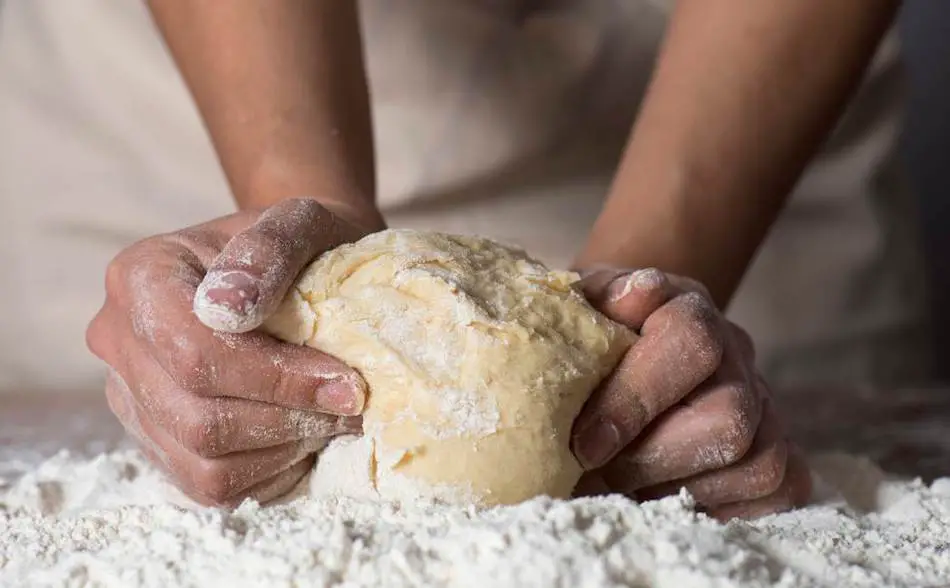
What About the Baking Soda?
Baking soda is a basic ingredient that works as a yeast substitute by releasing carbon dioxide gas when exposed to an acid. The carbon dioxide gas gets trapped in the dough, causing it to rise and become light and airy.
When baking soda (a base) is combined with an acid, such as vinegar or yogurt, it reacts to produce carbon dioxide gas. This gas gets trapped in the gluten network of the dough, causing it to rise and become light and airy.
The Difference Between Baking Soda and Baking Powder
Baking soda and baking powder are both chemical leavening agents, but they are different in several ways. Baking soda (sodium bicarbonate) is a basic ingredient that reacts with an acid to produce carbon dioxide gas. This gas gets trapped in the gluten network of the dough, causing it to rise and become light and airy. Baking soda is often used in recipes that contain an acid, such as vinegar or yogurt, to neutralize the bitter taste and improve the flavor of the bread.
Baking powder, on the other hand, is a combination of baking soda, an acid, and a drying agent. The acid and baking soda react with each other to produce carbon dioxide gas, and the drying agent helps to keep the powder dry, preventing it from reacting before it’s used. Baking powder is often used in recipes that don’t contain an acid, or when you want to add a light and airy texture to the bread without changing the flavor.
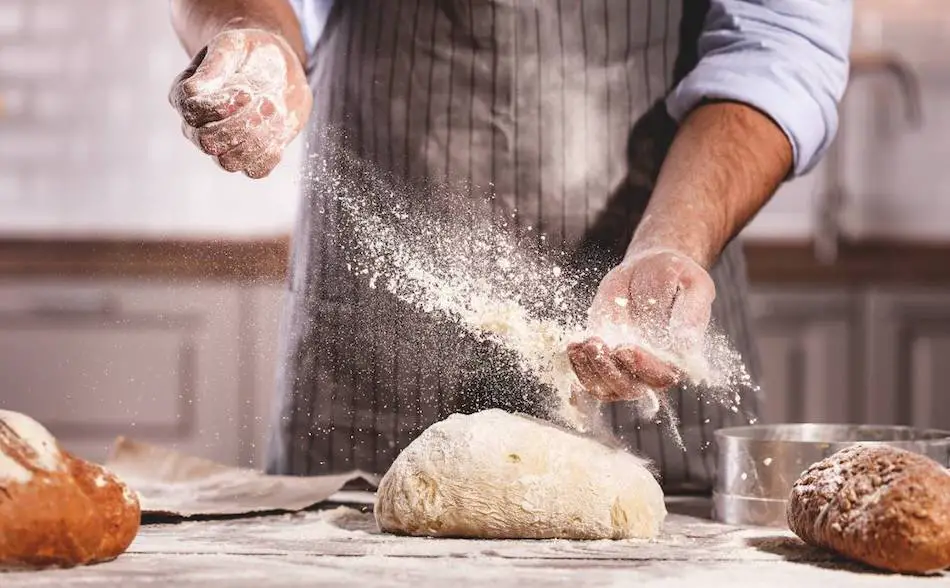
Vinegar as a Yeast Substitute
Vinegar, specifically acetic acid, can be used as a yeast substitute in bread making due to its acidic properties. When vinegar is combined with baking soda, the reaction between the acid and the base releases carbon dioxide gas, which gets trapped in the gluten network of the dough, causing it to rise and become light and airy.
Using vinegar as a yeast substitute is a quick and convenient option, and it can be used in recipes that don’t require yeast or when you don’t have any yeast on hand. However, it’s important to keep in mind that using vinegar as a yeast substitute can affect the flavor of the bread.
The acidic taste of vinegar can be overpowering, so it’s best to use it in small quantities and in combination with other ingredients, such as baking soda, to help neutralize the taste and improve the flavor of the bread.
The Science Behind Vinegar as a Yeast Substitute
The science behind vinegar as a yeast substitute is based on the reaction between vinegar and baking soda. Vinegar is an acidic ingredient, specifically acetic acid, and when it is combined with baking soda, a basic ingredient, a chemical reaction occurs that releases carbon dioxide gas. This gas gets trapped in the gluten network of the dough, causing it to rise and become light and airy.
Using Baking Powder as a Yeast Alternative in a Bread Machine:
Baking powder is a combination of baking soda and acid, and it provides a quick and convenient leavening option for bread making in a bread machine. To use baking powder in a bread machine recipe, you need to follow these steps:
- Measure the ingredients according to the recipe.
- Add the dry ingredients, including the flour and baking powder, to the bread machine.
- Add the wet ingredients, such as milk, water, eggs, and oil, to the bread machine.
- Start the bread machine according to the recipe’s instructions.
| Step | Instructions |
|---|---|
| 1 | Measure ingredients according to recipe. |
| 2 | Add dry ingredients (flour, baking powder) to bread machine. |
| 3 | Add wet ingredients (milk, water, eggs, oil) to bread machine. |
| 4 | Start bread machine according to recipe instructions. |
Using Baking Soda as a Yeast Alternative in a Bread Machine:
Baking soda is a leavening agent that can help bread rise when combined with an acidic ingredient such as vinegar or yogurt. To use baking soda in a bread machine recipe, you need to follow these steps:
- Measure the ingredients according to the recipe.
- Combine the baking soda with an acidic ingredient such as vinegar or yogurt.
- Add the dry ingredients, including the flour and baking soda mixture, to the bread machine.
- Add the wet ingredients, such as milk, water, eggs, and oil, to the bread machine.
- Start the bread machine according to the recipe’s instructions.
Using Baking Soda: Step-By-Step
| Step | Instructions |
|---|---|
| 1 | Measure ingredients according to recipe. |
| 2 | Combine baking soda with an acidic ingredient (vinegar, yogurt). |
| 3 | Add dry ingredients (flour, baking soda mixture) to bread machine. |
| 4 | Add wet ingredients (milk, water, eggs, oil) to bread machine. |
| 5 | Start bread machine according to recipe instructions. |
Using Yogurt as a Yeast Alternative in a Bread Machine
Yogurt is a versatile ingredient that can be used as a yeast alternative in bread making. Yogurt contains lactic acid that can help the bread rise and also add a tangy flavor. To use yogurt in a bread machine recipe, you need to follow these steps:
- Measure the ingredients according to the recipe.
- Add the yogurt to the wet ingredients, such as milk, water, eggs, and oil.
- Add the dry ingredients, including the flour, to the bread machine.
- Start the bread machine according to the recipe’s instructions.
How to Use Yogurt: Step-by-Step
| Step | Instructions |
|---|---|
| 1 | Measure ingredients according to recipe. |
| 2 | Add yogurt to wet ingredients (milk, water, eggs, oil). |
| 3 | Add dry ingredients (flour) to bread machine. |
| 4 | Start bread machine according to recipe instructions. |
Using Vinegar as a Yeast Alternative in a Bread Machine
Vinegar is another option for making bread without yeast. It contains acetic acid that reacts with baking soda to create carbon dioxide and help the bread rise. To use vinegar in a bread machine recipe, you need to follow these steps:
- Measure the ingredients according to the recipe.
- Add the vinegar to the wet ingredients, such as milk, water, eggs, and oil.
- Add the dry ingredients, including the flour, to the bread machine.
- Start the bread machine according to the recipe’s instructions.
| Step | Instructions |
|---|---|
| 1 | Measure ingredients according to recipe. |
| 2 | Add vinegar to wet ingredients (milk, water, eggs, oil). |
| 3 | Add dry ingredients (flour) to bread machine. |
| 4 | Start bread machine according to recipe instructions. |
Does Pre Made Bread Mix Have Yeast?
Pre-made bread mix is a pre-packaged mixture of dry ingredients required for making bread. It typically includes flour, salt, sugar, and sometimes other ingredients such as dried yeast or other leavening agents. The yeast in pre-made bread mix may be either active dry yeast or instant yeast.
The yeast is included to help the dough rise and give the bread its distinctive flavor and texture. The user simply adds water and any additional ingredients as instructed, mixes the dough, and bakes it in the oven or in a bread machine. Pre-made bread mix provides a convenient and quick way to make fresh bread, as all of the dry ingredients are already measured and blended together.
Advantages and Disadvantages of Yeast-Free Bread
Advantages of Yeast-Free Bread:
- Faster Preparation: Yeast-free bread can be made much faster than traditional yeast-based bread, as there is no waiting time for the yeast to activate or for the dough to rise.
- Convenient: Yeast-free bread is a convenient option for those who do not have yeast on hand or for those who want to avoid the hassle of making yeast bread from scratch.
- Shelf-Life: Yeast-free bread generally has a longer shelf-life compared to yeast-based bread, as it does not contain yeast that can cause the bread to go stale more quickly.
- Sensitivity: For those with yeast sensitivities or allergies, yeast-free bread can be a suitable alternative.
Disadvantages of Yeast-Free Bread:
- Texture: Yeast-free bread may have a denser, coarser texture compared to traditional yeast-based bread.
- Flavor: Yeast-free bread may lack the distinctive, slightly tangy flavor of yeast-based bread.
- Consistency: Yeast-free bread may not rise as much as yeast-based bread, which can affect the final shape and texture of the bread.
- Versatility: Yeast-free bread may not be suitable for all types of bread, such as light and airy loaves or sourdough.
- Cost: In some cases, yeast-free bread may be more expensive than yeast-based bread due to the cost of alternative ingredients and the pre-packaged bread mixes.
Sensitivity to Yeast: The Benefits of Yeast-Free Bread
- For those with yeast sensitivities or allergies, yeast-free bread can be a suitable alternative to traditional yeast-based breads.
- Yeast sensitivities can cause digestive discomfort, bloating, and other unpleasant symptoms.
- Yeast-free bread eliminates this concern, allowing those with sensitivities to enjoy the taste and texture of fresh baked bread without any negative side effects.
- This makes yeast-free bread an ideal option for individuals with dietary restrictions or who are looking for alternative baking options.
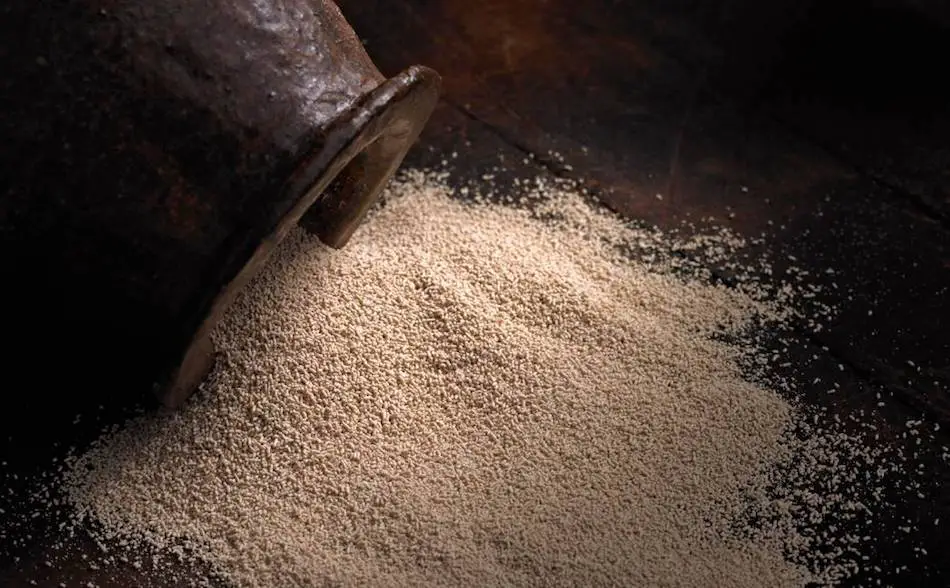
Shelf-Life: The Longevity of Yeast-Free Bread
- Yeast-free bread generally has a longer shelf-life compared to yeast-based bread.
- This is because yeast-free bread does not contain yeast, which is a natural leavening agent that causes the bread to rise.
- The absence of yeast in yeast-free bread means that there are no yeast cells present that can break down the starches in the bread and cause it to go stale more quickly.
- As a result, yeast-free bread can maintain its freshness for a longer period of time compared to yeast-based bread.
- This makes yeast-free bread a more convenient option for those who are looking to enjoy fresh baked bread without having to worry about it going stale quickly.
Yeast-Free Bread vs Traditional Yeast-Based Bread
The texture of yeast-free bread can be a noticeable difference compared to traditional yeast-based bread. Yeast-free bread often has a denser and coarser texture, lacking the soft and fluffy texture that is achieved by the yeast’s ability to produce carbon dioxide and expand the dough.
The texture of yeast-free bread can vary depending on the alternative leavening agent used, but it is generally denser than traditional bread. This can be a desirable feature for some consumers who prefer a heartier bread, but for others it may take some time to get used to the different texture.
Taste Differences
The flavor of yeast-free bread is often different from yeast-based bread, as it doesn’t have the distinctive, slightly tangy taste that yeast imparts. Yeast contributes to the complex flavor profile of bread through the fermentation process, which yeast-free bread does not have. As a result, yeast-free bread may have a more neutral or bland flavor compared to traditional yeast-based bread.
However, the flavor of yeast-free bread can still be delicious, especially if ingredients like spices, fruits, or nuts are added to enhance the flavor. Additionally, yeast-free bread made with sourdough starter can have a unique and tangy flavor profile, as sourdough starters are naturally fermented by yeast and bacteria.
Difference in Consistency and Rise
The consistency and rise of yeast-free bread can be different from traditional yeast-based bread. As yeast is not present in yeast-free bread, the final product may not rise as much and have a denser texture. This can affect the final shape and texture of the bread, resulting in a more compact loaf.
To compensate for this, some yeast-free recipes call for more liquid or other leavening agents such as baking powder or baking soda. Additionally, the amount and type of flour used can also affect the final consistency and rise of yeast-free bread. It’s important to follow a trusted recipe and adjust as necessary to achieve the desired results.
Tips for achieving a successful outcome (with yeast free bread)
Here are a few tips for achieving a successful outcome when making yeast-free bread:
- Use a recipe specifically designed for yeast-free bread: This will help ensure that the right ingredients and ratios are used for a successful outcome.
- Experiment with different yeast alternatives: Different yeast alternatives such as baking soda, baking powder, sourdough starter, yogurt, and vinegar can result in different textures and flavors. Try experimenting to find the yeast alternative that works best for you.
- Be precise with measurements: Yeast-free bread does not have yeast to help it rise, so it is important to be precise with ingredients measurements to ensure that the right balance of ingredients is used.
- Add a source of acid: Many yeast alternatives, such as yogurt and vinegar, rely on acid to help the bread rise. Make sure to add a source of acid when making yeast-free bread.
- Pay attention to cooking time and temperature: Different yeast alternatives may require different cooking times and temperatures, so make sure to follow the recipe carefully to avoid over- or under-cooking the bread.
Variations and Flavor Additions for Yeast-Free Bread
Variations and flavor additions can be made to yeast-free bread to add interest and variety to your baking. Some common additions include herbs, spices, nuts, seeds, dried fruit, and cheese. You can also add a touch of sweetness with a natural sweetener such as honey or maple syrup.
Additionally, you can try using different types of flour, such as whole wheat, oat, or rye flour, to create unique textures and flavors. Experimenting with yeast-free bread is a great way to discover new and interesting bread recipes.

